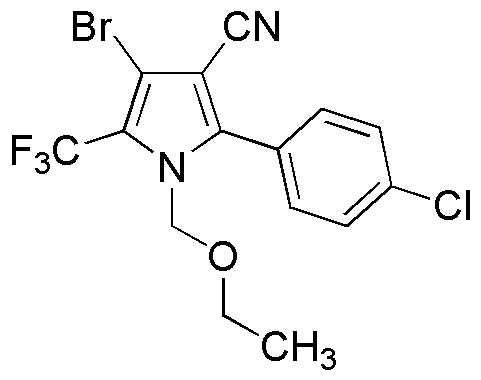Chlorfenapyr is widely utilized in research focused on:
- Agricultural Pest Control: This chemical is primarily used as an insecticide, effectively targeting a wide range of pests in crops such as cotton, soybeans, and vegetables, helping farmers protect their yields.
- Public Health Initiatives: Chlorfenapyr is employed in vector control programs to manage mosquito populations, reducing the spread of diseases like malaria and dengue fever, which is crucial for public health.
- Integrated Pest Management (IPM): It plays a significant role in IPM strategies, allowing for sustainable pest management by minimizing chemical use and promoting environmental safety.
- Termite Control: The compound is effective in controlling termite infestations in residential and commercial buildings, providing long-lasting protection against structural damage.
- Research and Development: Scientists utilize chlorfenapyr in studies to develop new formulations and improve pest resistance management, contributing to the advancement of agricultural practices.
Informations générales
Propriétés
Sécurité et réglementation
Applications
Chlorfenapyr is widely utilized in research focused on:
- Agricultural Pest Control: This chemical is primarily used as an insecticide, effectively targeting a wide range of pests in crops such as cotton, soybeans, and vegetables, helping farmers protect their yields.
- Public Health Initiatives: Chlorfenapyr is employed in vector control programs to manage mosquito populations, reducing the spread of diseases like malaria and dengue fever, which is crucial for public health.
- Integrated Pest Management (IPM): It plays a significant role in IPM strategies, allowing for sustainable pest management by minimizing chemical use and promoting environmental safety.
- Termite Control: The compound is effective in controlling termite infestations in residential and commercial buildings, providing long-lasting protection against structural damage.
- Research and Development: Scientists utilize chlorfenapyr in studies to develop new formulations and improve pest resistance management, contributing to the advancement of agricultural practices.
Documents
Fiches de données de sécurité (FDS)
La FDS fournit des informations de sécurité complètes sur la manipulation, le stockage et l’élimination du produit.
Spécifications du produit (PS)
Le PS fournit une description complète des propriétés du produit, notamment sa composition chimique, son état physique, sa pureté et les exigences de stockage. Il détaille également les plages de qualité acceptables et les applications prévues du produit.
Certificats d'analyse (COA)
Recherchez des certificats d'analyse (COA) en saisissant le numéro de lot du produit. Les numéros de lot et de lot se trouvent sur l'étiquette d'un produit, après les mots « Lot » ou « Lot de fabrication ».
Numéro de catalogue
Numéro de lot/série
Certificats d'origine (COO)
Ce certificat d'exploitation confirme le pays dans lequel le produit a été fabriqué, et détaille également les matériaux et composants utilisés et s'il est issu de sources naturelles, synthétiques ou autres sources spécifiques. Ce certificat peut être requis pour les douanes, le commerce et la conformité réglementaire.
Numéro de catalogue
Numéro de lot/série
Fiches de données de sécurité (FDS)
La FDS fournit des informations de sécurité complètes sur la manipulation, le stockage et l’élimination du produit.
DownloadSpécifications du produit (PS)
Le PS fournit une description complète des propriétés du produit, notamment sa composition chimique, son état physique, sa pureté et les exigences de stockage. Il détaille également les plages de qualité acceptables et les applications prévues du produit.
DownloadCertificats d'analyse (COA)
Recherchez des certificats d'analyse (COA) en saisissant le numéro de lot du produit. Les numéros de lot et de lot se trouvent sur l'étiquette d'un produit, après les mots « Lot » ou « Lot de fabrication ».
Numéro de catalogue
Numéro de lot/série
Certificats d'origine (COO)
Ce certificat d'exploitation confirme le pays dans lequel le produit a été fabriqué, et détaille également les matériaux et composants utilisés et s'il est issu de sources naturelles, synthétiques ou autres sources spécifiques. Ce certificat peut être requis pour les douanes, le commerce et la conformité réglementaire.


